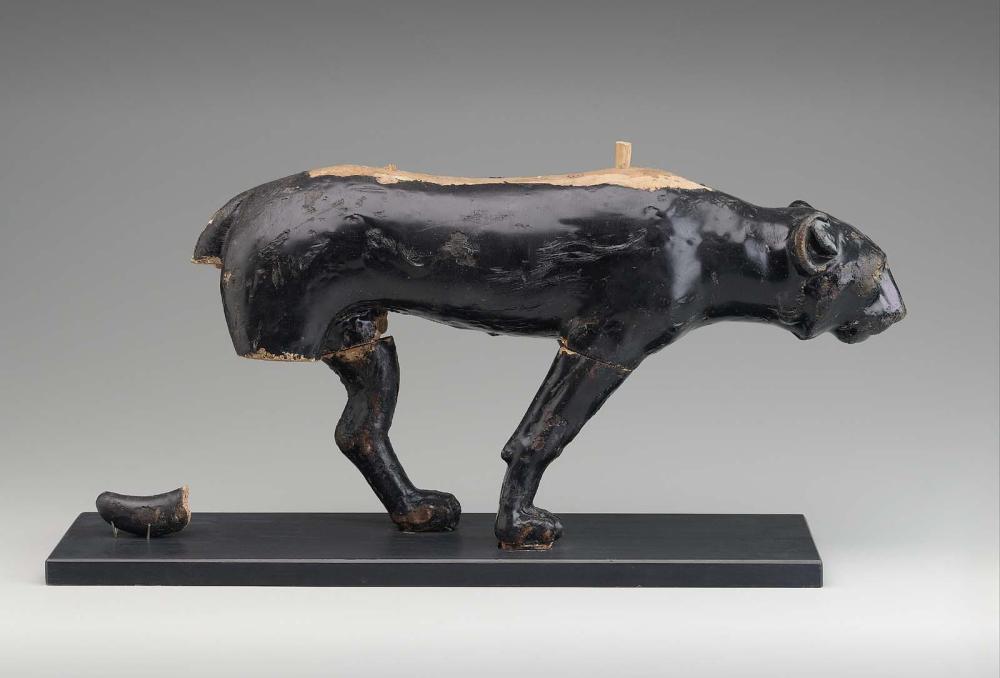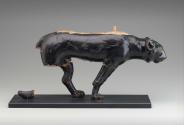Advanced Search
Leopard of Thutmose IV
Egyptian
New Kingdom, Dynasty 18, reign of Thutmose IV
1400–1390 B.C.
Findspot: Egypt, Thebes, Valley of the Kings, KV 43
Medium/Technique
Wood covered with bitumen
Dimensions
Height x width x length: 32.5 x 12.5 x 67 cm (12 13/16 x 4 15/16 x 26 3/8 in.)
Credit Line
Gift of Theodore M. Davis
Accession Number03.1137a-b
NOT ON VIEW
CollectionsAncient Egypt, Nubia and the Near East
ClassificationsSculpture
DescriptionThe Egyptians always excelled at animal sculpture. This leopard from the tomb of Thutmose IV is wonderfully naturalistic, striding stealthily forward, left paws advanced, neck craning ahead, head lowered. Its long tail trails gracefully behind, curving up at the tip. Its skin is not spotted, but black. Because black was the color of the fertile Nile silt and thus held the promise of resurrection, artisans liberally slathered black bitumen over all types of funerary equipment for the material's symbolic value as well as for its preservative properties.
Made of six pieces of wood joined together - the body, the four legs, and the tail - along with inlaid eyes that are now lost, the animal has two rectangular mortises on its back for the insertion of tenons. The leopard, therefore, did not stand alone, but was part of a group composition. From similar sculptures found intact in the tomb of Tutankhamen and from painted images, we know that each leopard carried on its back a striding figure of the king. Wrapped in linen shawls and stored in black wooden shrines, such sculptural groups appear to have been standard items of New Kingdom royal funerary equipment.
The leopard was not the king's adversary, but rather his hunting companion and escort. In ancient times, the wild leopard had a much wider distribution than it does now; it inhabited most of Egypt and was at home in both the desert and wetlands. Moving between two worlds as a liminal being, it was a fitting escort for the deceased. Both marsh and desert were perceived as battle zones, no-man's lands between the world of the living and the world of the dead. The passage through these unknown regions was full of obstacles, manifested in the wild and dangerous animals that needed to be overcome by the king and his leopard working side by side in the battle between good and evil.
In another interpretation, the leopard was an ancient sky goddess, her pelt studded with stars straddling the nocturnal horizon. This notion ties the animal in with the solar circuit, the king's vehicle across the heavens (like the solar boat) that protected him along the way and ensured his safe journey.
Made of six pieces of wood joined together - the body, the four legs, and the tail - along with inlaid eyes that are now lost, the animal has two rectangular mortises on its back for the insertion of tenons. The leopard, therefore, did not stand alone, but was part of a group composition. From similar sculptures found intact in the tomb of Tutankhamen and from painted images, we know that each leopard carried on its back a striding figure of the king. Wrapped in linen shawls and stored in black wooden shrines, such sculptural groups appear to have been standard items of New Kingdom royal funerary equipment.
The leopard was not the king's adversary, but rather his hunting companion and escort. In ancient times, the wild leopard had a much wider distribution than it does now; it inhabited most of Egypt and was at home in both the desert and wetlands. Moving between two worlds as a liminal being, it was a fitting escort for the deceased. Both marsh and desert were perceived as battle zones, no-man's lands between the world of the living and the world of the dead. The passage through these unknown regions was full of obstacles, manifested in the wild and dangerous animals that needed to be overcome by the king and his leopard working side by side in the battle between good and evil.
In another interpretation, the leopard was an ancient sky goddess, her pelt studded with stars straddling the nocturnal horizon. This notion ties the animal in with the solar circuit, the king's vehicle across the heavens (like the solar boat) that protected him along the way and ensured his safe journey.
ProvenanceFrom Egypt, Valley of the Kings, tomb KV 43 (Thutmose IV). 1903: excavated by Theodore M. Davis, under the direction of Howard Carter; given to the MFA by Theodore M. Davis.
(Accession Date: June 11, 1903)
(Accession Date: June 11, 1903)



